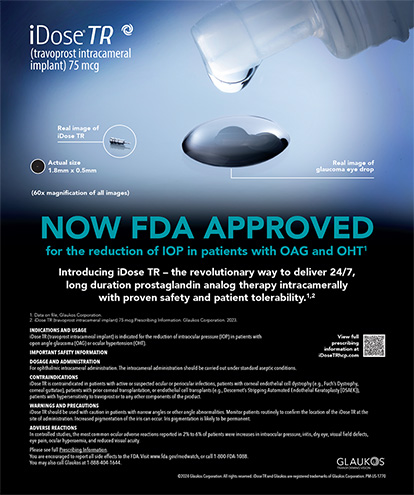For nearly 2 years, I've had the privilege of offering commentary on the changes in marketing and customer service that providers must make in order for refractive surgery to gain mainstream acceptance. As refractive technology reaches a new peak with fully customized solutions, the focus of physicians' efforts should increasingly shift toward marketing. One of the key themes of this column has been that marketing involves much more than traditional advertising. A successful practice looks at every element outside of the procedure as part of its marketing strategy, and it continually examines what needs to improve and why the improvements will benefit patients. This month's article examines a different issue: how change occurs.
NO PAIN, NO GAIN
Oftentimes, as the practitioner, you know you need to do things differently within your practice to grow it. You might even have an idea or two about what needs to be done. You talk the matter over with your staff, get everyone excited, and give it a shot. New policy, new hours, new coffee—whatever the solution, you test it out, then quite often revert back to the old way of doing things. Why? Frankly, the process of change is difficult. Or, what turned out to be a great new marketing idea for your colleague's laser center may absolutely bomb in yours. What happened?
The problem may be with the idea itself: wrong idea, wrong timing, wrong environment. I suspect, however, that the root cause of failed marketing tactics in most refractive practices has more to do with the process used to implement the idea. In other words, the approach you take to implementing new marketing programs or clinical procedures is as critical as the ideas and procedures themselves. Surgeons are used to having “command and control,” especially within the surgical suite. As a managerial style, however, this approach often kills creativity and staff morale and is doomed for failure.
MAKING CHANGE HAPPEN—A CASE STUDY
Back when internships were a noble pursuit, I had the opportunity to work for an incredible organizational development guru named Kathleen Dannemiller. Her client roster included Ford Motor Company, The Boeing Company, Marriott International, Inc., and a multitude of other large and small companies that were “in trouble.” Their reputations for old-school management with rust-belt technology often made the task for Kathleen's consulting firm seem like a climb up Mt. Everest.
Kathleen's skilled ability to work with CEOs and senior executives developed not from any industry-specific technical expertise, but rather from her insights and research into the process of change. When Kathleen worked with a corporate client, she organized strategic planning sessions that brought together all levels of management and employees—sometimes, entire divisions—in a single room for several days at a time. The employees conducted exercises that helped them understand each other's working styles, truly listen to their colleagues, and collaborate on action plans that could be readily implemented once everyone returned “back home” to their offices. Kathleen's approach to strategic planning in “real time” helped new changes to actually take place within these organizations, as opposed to creating a thick binder that sat on a bookshelf untouched until the next strategic planning session.
Before she retired several years ago, Kathleen's organizational development methods were trademarked as WholeScale Change processes. Her success as a “change agent” has undoubtedly influenced products and services in the marketplace. Tens of thousands of corporate managers have experienced the paradigm shift that often occurs when coworkers truly listen to one another and thereby transform diverse interests into common goals. One of Kathleen's most powerful tools is a theory on why change occurs (or fails to occur). The theory is a simple formula known as DVF (Figure 1).
Think of “D” as the dissatisfaction you feel about a given situation. Something's wrong, and you believe it needs to be fixed. “V” becomes the vision of what is possible—that is, the end result of successfully changing the situation. “F” represents those crucial first steps that start you on the path toward change. Each component of this theory must be in place for the change to take place. If one element is missing, the equation equals zero. Nothing changes, because zero will automatically be less than “R,” the resistance to change humans naturally feel.
INITIATING CHANGE IN REFRACTIVE SURGERY
Although resisting change may be natural, altering your thoughts and actions in regard to refractive surgery is paramount if the category is ever going to move beyond niche status and reach mainstream consumers. Over time, the product of refractive surgery will undoubtedly improve. For now, however, you must use the best leveraging tool available—your customer service—and work to improve it at every point in your practice.
If you're struggling for ideas on how to improve your customer service, I suggest reading tips from one of the great brand marketers of our day, Harry Beckwith, author of Selling the Invisible. This book is a service marketer's dream come true. Beckwith was among the first to understand that the marketing of services—an intangible event that depends on the person performing it—is inherently different than the marketing of products—“goods” that you can see, hold, and take home after purchasing. Pulling from several decades of experience with hundreds of companies, Beckwith inspires the reader with tips on how to improve customer service. (See Shareef's Summer Reading List.)
ENLISTING HELP
Finally, don't try implementing change within your practice alone! New processes almost always work better and last longer when their development involves other people who will be affected. Further, your staff members often have more insight into the things that need to change than you do, because they spend more time with patients and encounter more of the hurdles involved in running the practice. Listen to what they have to say … you might just learn a thing or two.


